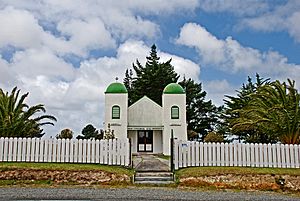Te Kao facts for kids
Quick facts for kids
Te Kao
|
|
|---|---|

The Rātana Church at Te Kao is characterised by bell towers at each of the front corners, which bear the words "Arepa" and "Omeka" (Maori transliterations of the Greek words Alpha and Omega – the beginning and the end)
|
|
| Country | New Zealand |
| Region | Northland Region |
| District | Far North District |
| Ward | Te Hiku |
| Community | Te Hiku |
| Subdivision | North Cape |
| Electorates |
|
Te Kao is a small village located on the Aupouri Peninsula in the Northland Region of New Zealand. It is a very important place for the Te Aupōuri people. They are the mana whenua, which means they are the traditional people who have authority over this land.
Te Kao is the main settlement for the Te Aupōuri iwi (tribe). The tribe's main office, their special meeting place called a marae, and their cemetery are all here. State Highway 1, a major road, goes right through the area. Te Kao is about 46 kilometers south of Cape Reinga and 24 kilometers north of Houhora. To the west, you'll find the Aupouri Forest and the famous Ninety Mile Beach.
Contents
What Does "Te Kao" Mean?
The name "Te Kao" has a special meaning in the Māori language. According to the New Zealand Ministry for Culture and Heritage, "Te Kao" means "the dried kūmara". Kūmara is a type of sweet potato, and it was a very important food for Māori people.
A Famous Runner's Start
Te Kao is also known for a legendary athlete named Te Houtaewa. He was from the Te Aupōuri tribe. The story says that Te Houtaewa began his amazing run along Ninety Mile Beach right here in Te Kao. He is a famous figure in Māori stories.
Who Lives in Te Kao?
This section tells us about the people who live in Te Kao. It looks at how many people live there and where they come from.
How Many People Live Here?
The population of Te Kao has been growing. In the 2023 New Zealand census, 183 people lived in the area. This was an increase of 27 people since the 2018 census. It was also a big increase of 78 people since the 2013 census.
There were 87 males and 96 females living in 66 homes. The average age of people in Te Kao was 32.6 years old. About 26% of the people were under 15 years old. Around 21% were between 15 and 29 years old. Most people, about 38%, were between 30 and 64. About 15% were 65 years or older.
Different Backgrounds, One Community
People in Te Kao come from different backgrounds. Many people identify as Māori, about 88.5%. Around 24.6% identify as European (also called Pākehā). Some people also identify as Pasifika or Asian.
Most people in Te Kao speak English, about 96.7%. Many also speak the Māori language, about 49.2%. A small number of people, 4.9%, were born outside of New Zealand.
When it comes to beliefs, about 32.8% of people follow Christian faiths. Another 32.8% follow Māori religious beliefs. About 31.1% of people said they did not have a religion.
The Marae: A Special Meeting Place
Pōtahi Marae is a very important place in Te Kao. It is the traditional meeting place for the Te Aupōuri people. A marae is a special area that includes a meeting house, called a wharehui, and a dining hall, called a wharekai.
The meeting house at Pōtahi Marae is named Waimirirangi. The dining hall is called Te Rongopātūtaonga. In 2020, the New Zealand Government helped to upgrade the marae. This project also created new jobs for people in the area.
Learning in Te Kao
Te Kura o Te Kao is the local school in the village. It is a school for both boys and girls. Students from year 1 to year 8 attend this school. As of February 2024 , it has a roll of 64 students.
The school first opened in 1881 as Te Kao Native School. For a while, it was called Te Kao Area School and taught students up to year 13. However, because there were not many older students, it became a primary school again in 1999.
In 2006, the school celebrated its 125th birthday. In 2019, Te Kura o Te Kao became a special "designated character school." This means it has a unique focus, often on Māori language and culture. In 2020, the school expanded again to include students in years 9 and 10.

